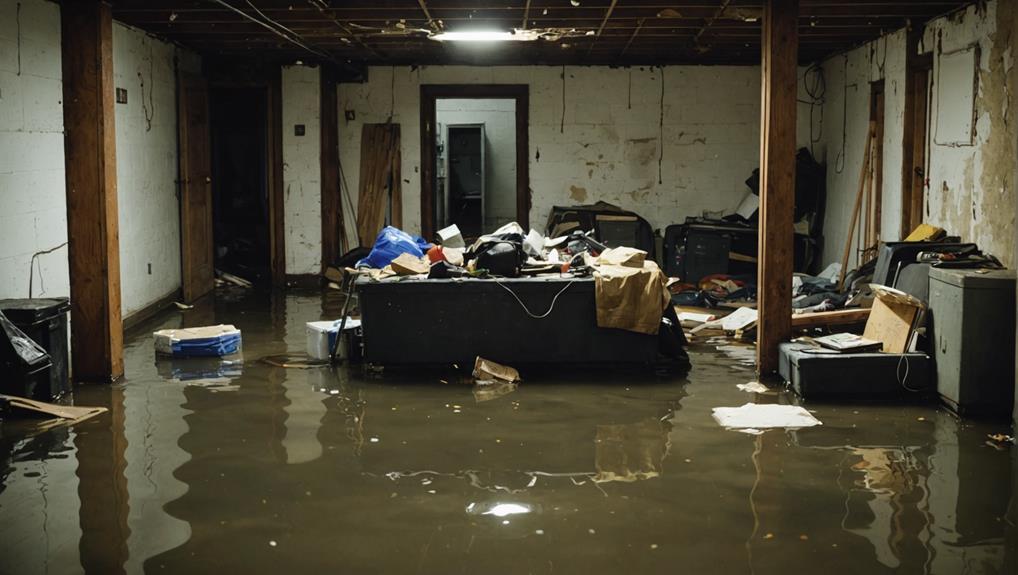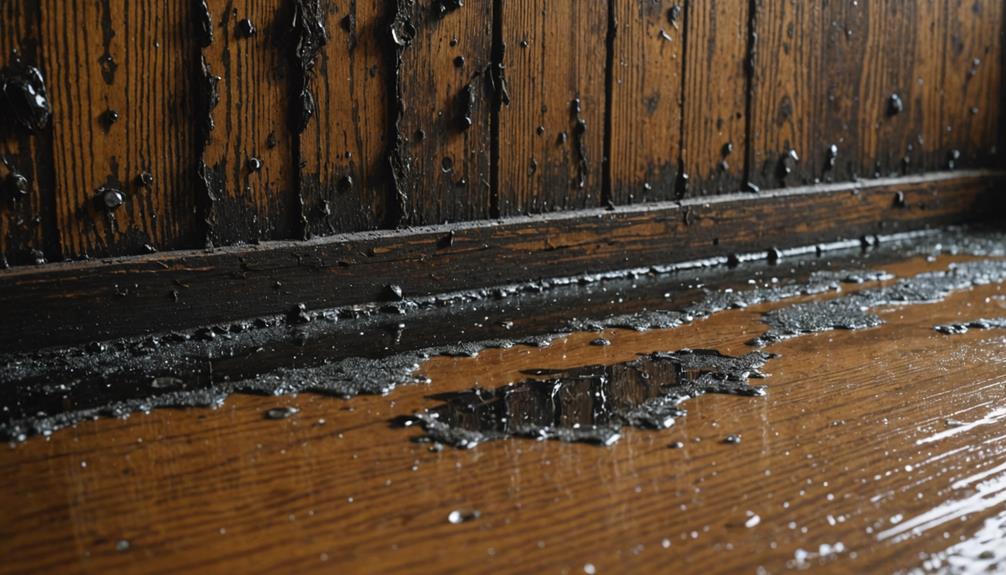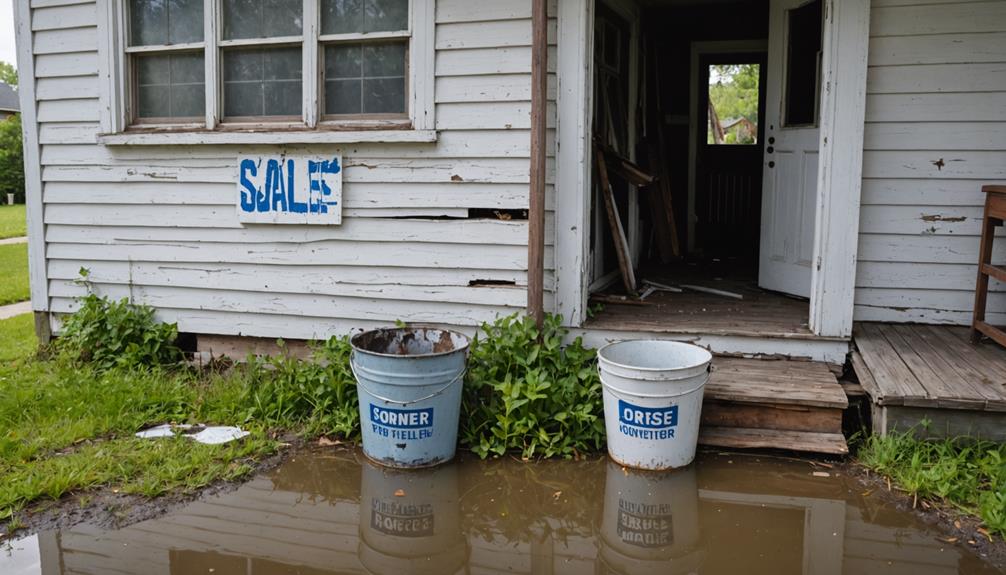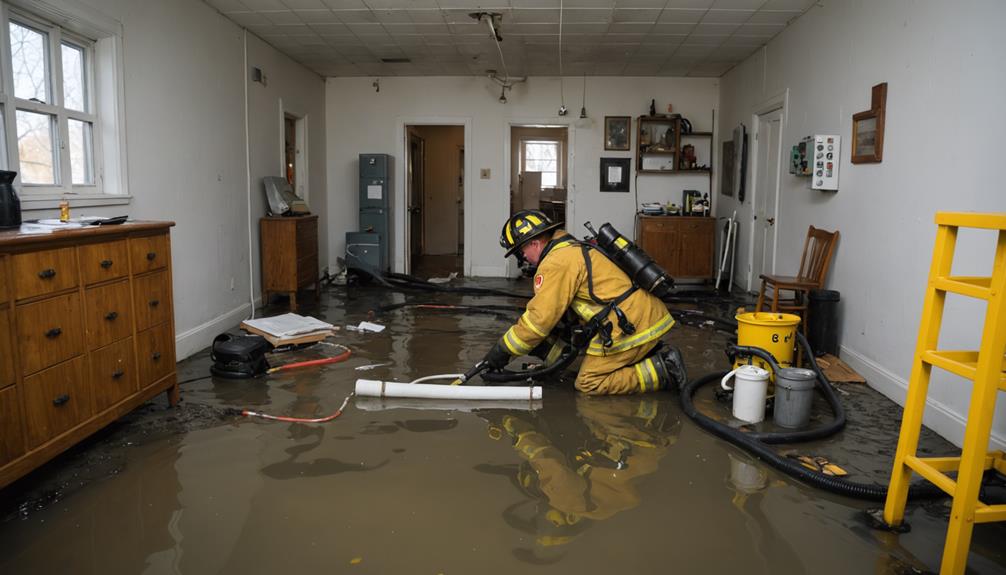Water damage affects millions every year, causing significant repair costs that can range from $1,000 to $10,000. You might be shocked to learn that mold can develop within just 24-48 hours, posing severe health risks. Many homeowners also overlook the fact that standard insurance often doesn't cover slow leaks or flood damage, leading to financial pitfalls. Furthermore, minor issues can devalue your home by 5-20%. With limited DIY solutions for extensive damage, knowing when to call professionals is essential. Understanding these impacts is critical, and there's much more you should know about safeguarding your property.
Water Damage Is Widespread

Water damage is more common than you might think, affecting millions of homes and businesses each year. Various water sources, such as burst pipes, heavy rainfall, or appliance malfunctions, can lead to significant issues if not addressed promptly. As a homeowner, you bear the responsibility of implementing damage prevention strategies, including regular property inspections and establishing emergency plans.
Understanding your insurance types is essential, as they can vary in coverage for water damage claims. Familiarizing yourself with local regulations will help you navigate restoration techniques effectively, ensuring compliance while minimizing disruption. Environmental factors, like humidity and proximity to water bodies, can worsen damage, making proactive measures even more critical.
Repair timelines can vary widely based on the extent of damage and the efficiency of your restoration process. By being informed and prepared, you can mitigate risks and tackle water damage head-on. Remember, the key to protecting your property lies in your vigilance and understanding of these factors, ensuring your home remains a safe haven for you and your loved ones.
Hidden Costs of Repairs
When dealing with water damage, you might encounter unexpected repair expenses that can quickly escalate. Furthermore, long-term structural issues may arise, complicating the repair process and increasing costs. It's important to understand your insurance coverage limitations, as they may not fully address these hidden financial burdens.
Unexpected Repair Expenses
Hidden costs associated with water damage repairs can quickly escalate, catching homeowners off guard. When dealing with hidden leaks, the initial repair costs may seem manageable, but several factors can contribute to unexpected expenses. Understanding these potential pitfalls is essential for effective budgeting and planning.
| Expense Type | Potential Cost Range | Notes |
|---|---|---|
| Structural Repairs | $1,000 – $10,000 | Depends on damage extent |
| Mold Remediation | $500 – $6,000 | Often necessary if leaks are hidden |
| Restoration Services | $200 – $5,000 | Varies based on repair timelines |
| Emergency Services | $100 – $1,500 | 24/7 access can add to costs |
If you don't address these hidden leaks promptly, you might face skyrocketing repair timelines and costs. Furthermore, the emotional strain of unexpected expenses can add pressure to an already challenging situation. Being proactive in identifying water damage early can save you from these financial surprises, allowing you to maintain control over your home.
Long-Term Structural Issues
The consequences of neglecting water damage can lead to significant long-term structural issues that often go unnoticed until it's too late. Water infiltration can compromise your home's structural integrity, causing materials like wood and drywall to weaken over time. What starts as a small leak can escalate into severe decay, mold growth, and even the need for extensive renovations.
You might think you've addressed the immediate problem, but water can silently seep into walls and foundations, eroding support systems you rely on daily. When structural integrity falters, it doesn't just threaten your home; it poses risks to your safety and financial stability. Hidden costs of repairs can soar as you face not only the initial damage but likewise the consequences of delayed maintenance.
Ignoring these issues can lead to costly structural repairs that require skilled professionals and potentially extensive renovations. It's essential to remain vigilant about any signs of water damage. Regular inspections and prompt action are your best defenses against the long-term ramifications of water infiltration. Don't overlook these risks; they can turn into nightmares if left unchecked.
Insurance Coverage Limitations
While many homeowners assume their insurance will cover all water damage repairs, gaps in coverage can lead to unexpected financial burdens. It's crucial to review your policy carefully, as many standard homeowners' insurance plans include policy exclusions that can leave you vulnerable. For instance, damage resulting from flooding often requires separate flood insurance, which isn't automatically included in standard coverage.
You might be surprised to find that certain types of water damage—like slow leaks or maintenance-related issues—are frequently excluded from coverage. These coverage gaps can result in significant out-of-pocket expenses when you need repairs the most. Furthermore, some insurers may impose limits on specific types of damage, meaning you could end up footing the bill for repairs that exceed those limits.
To protect yourself, take a proactive approach. Consult with your insurance agent to understand your coverage thoroughly and identify any potential gaps. Consider supplemental policies if necessary. By being informed and prepared, you can mitigate the financial impact of water damage and safeguard your home against unexpected repair costs.
Mold Growth Risks

After experiencing water damage, you might not realize the immediate danger lurking in your home: mold growth. Mold thrives in damp environments, and left unchecked, it can severely compromise your indoor air quality. Even small amounts of water can trigger a mold outbreak within 24 to 48 hours, making prompt action essential.
To protect your home, it's important to implement effective mold prevention strategies right away. Start by thoroughly drying out any affected areas, including walls, floors, and furniture. Use dehumidifiers to reduce humidity levels, ideally keeping them below 50%. Ventilation is also key; confirm that bathrooms and kitchens are well-ventilated to prevent moisture accumulation.
Regular inspections of hidden areas, like behind appliances and under sinks, can help catch potential mold growth early. If you find mold, it's necessary to address it immediately, as exposure can lead to health issues, including allergies and respiratory problems. Remember, maintaining a clean and dry environment is your best defense against mold. By being proactive, you can safeguard your home and promote a healthier living space for you and your loved ones.
Insurance Coverage Myths
When it comes to water damage, you might have some misconceptions about your insurance coverage. Many people believe that standard homeowners' policies fully cover all types of water damage, but this isn't always the case. Understanding the nuances of coverage types and the challenges in the claims process is essential to protecting your property effectively.
Common Misconceptions Explained
Many homeowners hold misconceptions about their insurance coverage regarding water damage, leading to confusion and unexpected expenses. Understanding these common water myths can help you navigate your insurance policy more effectively, ensuring your damage perception aligns with reality.
| Water Myth | Reality |
|---|---|
| Homeowners assume all water damage is covered. | Many policies exclude specific types of water damage, such as flooding. |
| You think your policy covers mold damage. | Mold often requires separate coverage because of its specific nature and risk. |
| You believe your insurance will cover negligence. | Most policies deny claims if damage results from homeowner neglect or lack of maintenance. |
These misconceptions can lead to major financial pitfalls when a water event occurs. It's essential to read your policy closely and consult with your insurer to clarify what's covered. By doing so, you'll not only improve your understanding of your coverage but additionally protect yourself from potential financial burdens in the future. Remember, a proactive approach is your best defense against the unexpected.
Types of Coverage
Understanding the complexities of water damage coverage is crucial for homeowners seeking to protect their assets. Many believe that their standard homeowners insurance policy covers all water-related incidents, but that's a common myth. In reality, there are various types of policies, each with distinct coverage limits.
For instance, a standard policy typically covers sudden and accidental water damage, like a burst pipe. Nevertheless, it often excludes damage from gradual leaks or flooding. If you live in a flood-prone area, you might need a separate flood insurance policy to guarantee your home is adequately protected.
It's additionally critical to understand your coverage limits. These limits can vary greatly between policies, affecting how much you can claim for repairs. Some policies might cap payouts for specific types of water damage, while others may not cover certain costs at all, like mold remediation.
To make knowledgeable choices, review your policy details carefully and consult with your insurance agent. By understanding the types of coverage available and their respective limits, you can better safeguard your home from the unexpected financial burdens of water damage.
Claim Process Challenges
Steering through the claim process for water damage can be fraught with challenges, largely due to prevalent insurance coverage myths. Many believe their policy covers all damage, but that's often not the case. It's essential to have a clear understanding of what your policy entails, including any exclusions or limitations. Misinterpretation can lead to underestimating the need for thorough claim documentation.
When you file a claim, your insurer will scrutinize your documentation closely. This means you need to provide extensive evidence of the damage, including photographs, repair estimates, and a detailed account of the incident. Skimping on this can result in delays or denials.
Another common myth is that all water damage is treated the same. In reality, the type of water involved—be it clean, grey, or black—can greatly affect coverage. It's important to interpret your policy accurately to understand the implications of this classification.
Ultimately, clear communication with your insurer and precise documentation can ease many of these challenges. Don't let myths cloud your understanding; instead, equip yourself with knowledge to navigate the claim process effectively.
Home Value Impact

Water damage can considerably diminish a home's value, often leaving lasting consequences that affect both resale potential and market appeal. When you're facing a water damage situation, it's essential to understand how it can lead to property depreciation and impact your home appraisal.
Here's a quick overview of how water damage can affect different aspects of home value:
| Damage Type | Impact on Home Value | Repair Cost Estimate |
|---|---|---|
| Minor Leaks | 5-10% decrease | $500 – $1,500 |
| Mold Growth | 10-20% decrease | $1,500 – $3,000 |
| Structural Damage | 20-40% decrease | $3,000 – $10,000+ |
| Foundation Issues | 30-50% decrease | $5,000 – $15,000+ |
| Total Loss | 50-100% decrease | Varies widely |
Even minor water issues can lead to significant property depreciation over time. When potential buyers see the consequences of water damage, they often hesitate, leading to a lower home appraisal. Being proactive in addressing these issues can save you thousands down the line and preserve your home's value.
Prevention Is Key
To effectively prevent water damage, you need to implement regular maintenance practices and develop emergency preparedness strategies. Routine inspections of plumbing and roofing can identify potential issues before they escalate. Moreover, having a solid plan in place for emergencies helps mitigate damage when unforeseen events occur.
Regular Maintenance Practices
Regular maintenance practices are vital in preventing costly water damage in homes and businesses. By implementing regular inspections and proactive measures, you can greatly reduce the risk of water-related issues. Here's a simple guide to help you stay on top of your maintenance routine:
| Maintenance Task | Frequency |
|---|---|
| Inspect Roof & Gutters | Twice a Year |
| Check for Leaks | Monthly |
| Test Sump Pump | Quarterly |
| Clean Drains | Annually |
Conducting these inspections allows you to catch potential problems early. For instance, checking your roof and gutters twice a year can help prevent clogs that lead to overflow and leaks. Monthly leak checks in areas like under sinks and around appliances make certain you're not overlooking small issues that could escalate. Testing your sump pump quarterly assures that it's functioning properly when you need it most. Finally, cleaning drains annually removes buildup that could cause blockages.
Emergency Preparedness Strategies
Identifying potential water damage issues through regular maintenance is just the first step; having a robust emergency preparedness strategy in place is just as crucial. You need to proactively plan for any potential water-related emergencies to minimize damage and protect your loved ones. Start by assembling thorough emergency kits that include necessary supplies such as bottled water, non-perishable food, flashlights, batteries, and first aid items. Keep these kits easily accessible and guarantee all family members know their locations.
Next, develop clear evacuation plans. Identify safe routes and designated meeting points for your family in case of a sudden water crisis. Practice these plans regularly to confirm everyone understands what to do. Consider incorporating communication strategies, like a group messaging app, to stay connected during emergencies.
Moreover, familiarize yourself with your local emergency services and their resources. Being informed can greatly reduce the stress and confusion during a crisis. Remember, your preparedness not only protects your property but likewise safeguards the safety and well-being of those you cherish most. So, take these steps today to fortify your home against water damage risks.
Seasonal Vulnerabilities

During certain times of the year, homes become particularly susceptible to water damage due to seasonal changes. Seasonal storms can lead to increased flooding patterns, often catching homeowners off guard. Understanding these vulnerabilities can help you mitigate potential damage.
Here are a few key factors to examine:
- Heavy Rainfall: Increased precipitation can overwhelm drainage systems.
- Melting Snow: Spring thaw can cause rapid runoff and flooding.
- Hurricanes: Coastal areas face extreme risks during hurricane season.
- Ice Dams: Winter temperatures can cause ice to build up on roofs, leading to leaks.
- Humidity Levels: High humidity in summer can promote mold growth, exacerbating water issues.
Long-Term Health Effects
Long-term exposure to water damage can lead to significant health issues that often go unnoticed until they become serious. The presence of mold and dampness in your living environment can trigger respiratory issues, including chronic cough and asthma. You might not realize that these symptoms can escalate over time, affecting your overall lung function.
Moreover, the psychological impact of living in a water-damaged home can contribute to cognitive decline and mental health problems. Constant exposure to allergens can overwhelm your immune response, leading to increased sensitivity and the development of skin irritations. It's not just physical health at stake; your emotional well-being can suffer, too.
Allergy triggers such as dust mites and mold spores flourish in damp conditions, exacerbating existing allergies and creating new ones. This cycle of irritation and immune response can leave you feeling exhausted and on edge. Being aware of these long-term effects can empower you to take action. If you suspect water damage in your home, addressing it promptly is essential for your health and peace of mind. Don't wait for symptoms to become dire; your well-being deserves immediate attention.
Emergency Response Importance

An effective emergency response to water damage is crucial for minimizing both immediate and long-term consequences. When faced with a water-related crisis, your response time can greatly impact the overall outcome. Here's why prompt action matters:
- Prevents structural damage
- Reduces mold growth risk
- Preserves personal belongings
- Guarantees safety for occupants
- Aids effective crisis management
By understanding the importance of emergency response, you can prioritize rapid action. When water infiltrates your space, it creates an environment ripe for damage. The longer you wait, the more severe the repercussions can be. Every minute counts, and the quicker you can initiate a response, the better your chances are of salvaging your property.
Implementing a structured crisis management plan can optimize your response during such emergencies. This plan should involve identifying potential risks, establishing clear communication lines, and knowing whom to contact for professional assistance. Ultimately, your preparedness and prompt response time can make all the difference in mitigating water damage and protecting your home. Don't underestimate the power of swift action; it's your frontline defense against the devastating effects of water damage.
DIY vs. Professional Help
When dealing with water damage, deciding between DIY methods and professional help can be challenging. Many homeowners consider DIY techniques to save money, believing they can tackle minor issues like small leaks or damp spots. Nonetheless, it's vital to recognize the limitations of these methods. DIY approaches often lack the depth of professional assessments, which can identify hidden damage or mold growth that you might overlook.
While you might feel confident in handling visible water damage, the underlying issues can pose significant risks. Professionals bring specialized equipment and expertise to effectively manage and remediate water damage, ensuring a thorough solution. They can evaluate the extent of the damage, perform necessary repairs, and prevent future occurrences.
Ultimately, the choice depends on the severity of the damage. For minor incidents, DIY techniques may suffice, but when facing extensive damage or structural concerns, it's wise to call in the professionals. Their insight not only aids in restoring your home but also safeguards your investment in the long run. Don't underestimate the complexity of water damage—sometimes, professional help is the best way to protect your space.
Conclusion
In conclusion, water damage isn't just a fleeting threat; it's a persistent peril that can lead to profound problems. From hidden costs to hazardous health effects, ignoring these issues isn't an option. You need to act swiftly and smartly, whether you're tackling DIY fixes or calling in the pros. Safeguarding your space from seasonal storms and mold mayhem is essential. Stay informed, stay prepared, and protect your property from the destructive movement of dampness.
